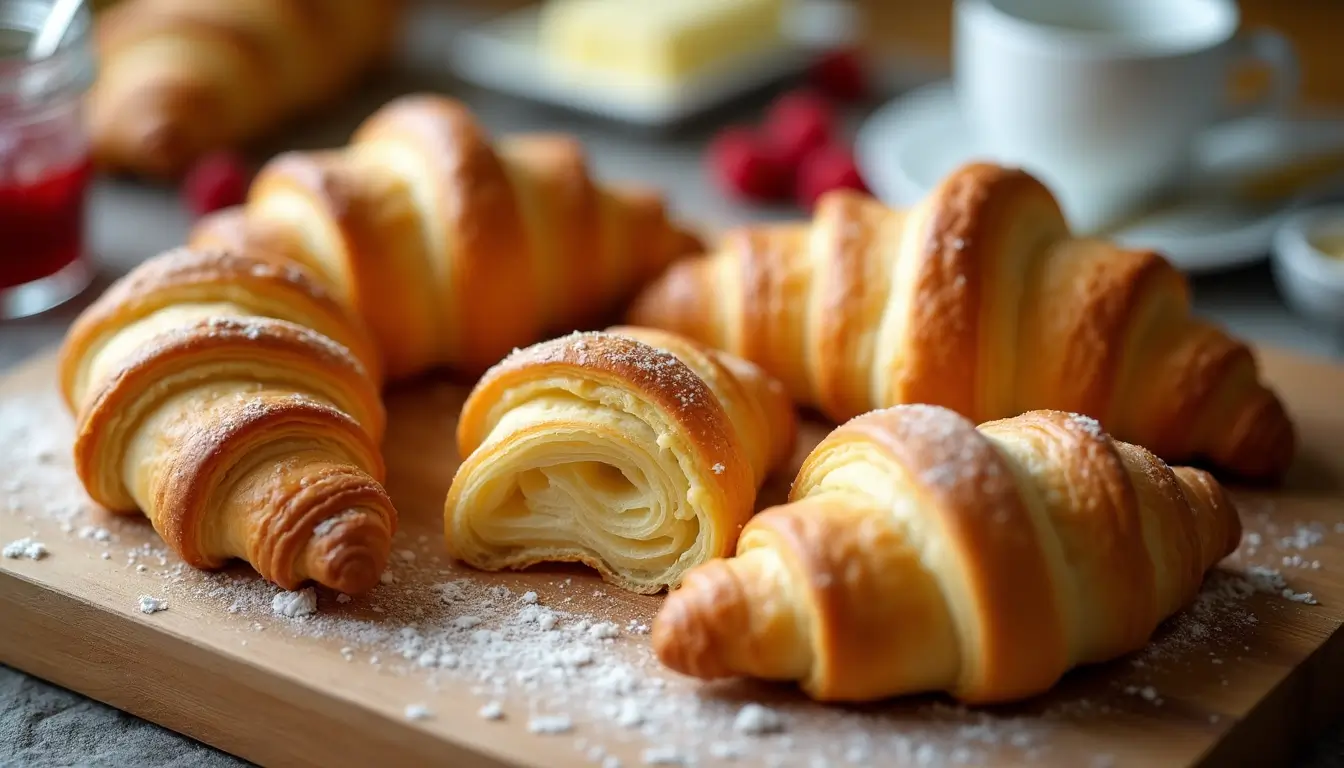The Swiss Gipfeli recipe might look like its French cousin, the croissant, but there’s something special about it. These Swiss pastries feature a distinctive crispy exterior and contain less butter and sugar than croissants, which creates their unique breakfast appeal.
Swiss families have cherished these flaky pastries right out of the oven through generations. They enjoy them with butter and jam or transform them into savory delights with cheese and ham fillings. A perfect gipfeli’s signature texture comes from its meticulously layered dough that needs to rest for 1.5 hours.
This Swiss gipfeli recipe will help you create these cherished pastries in your own kitchen. You’ll learn to prepare the simple dough and create those perfect flaky layers. Let’s take a closer look at this traditional Swiss delight and start baking!
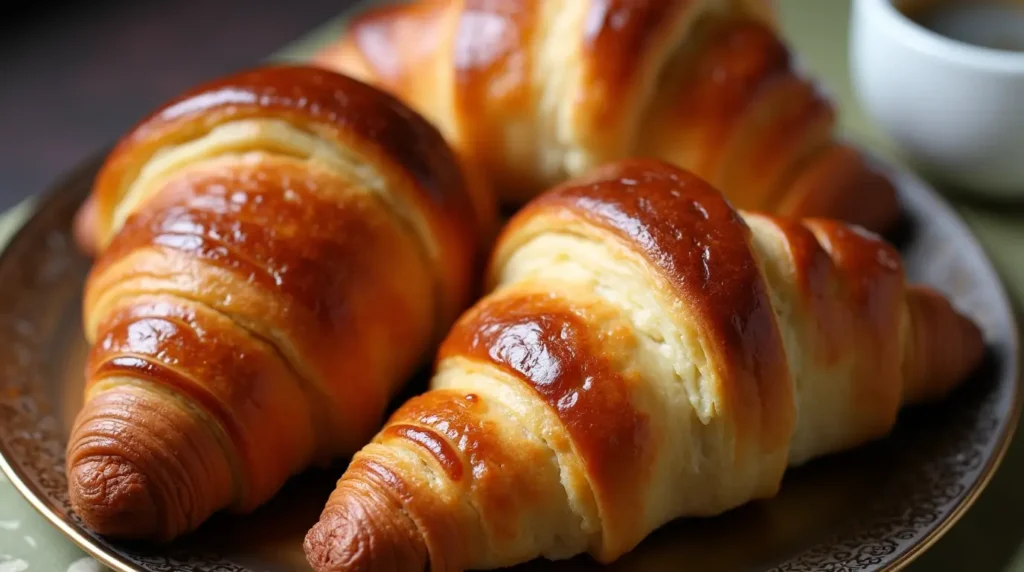
Table of Contents
The Story of Swiss Gipfeli Recipe
“Ein Gipfeli ist kein Croissant” — Herr Schmidt, Swiss baker mentioned in article
Swiss breakfast culture found its life-blood when Gipfeli recipe first appeared in the early 19th century. These distinctive pastries gained fame in Switzerland’s German-speaking regions because they had a crisper exterior and were nowhere near as buttery as their French cousins.
Origins in Swiss bakeries
Switzerland’s culinary fabric tells the story of Gipfeli recipe. These crescent-shaped treats showcase Swiss baking traditions’ simple elegance. Local bakeries throughout Switzerland mastered their craft and created pastries with the perfect balance of flakiness and density. Small bakeries produced superior handmade Swiss Gipfeli compared to mass-produced versions, though Swiss culture embraced both varieties.
Modern variations
Gipfeli’s progress has created many options that cater to different tastes. Traditional varieties include:
- Buttergipfeli – The classic butter version
- Schoggi-Gipfeli – Chocolate makes it special
- Laugengipfeli – Features a pretzel-style coating
- Vollkorngipfeli – Made with whole-grain flour
New interpretations have pushed beyond traditional recipes. Savory versions now come with ham and cheese fillings, while sweet ones feature almond paste or dark chocolate. Bakers experiment with different dough variations and some add herbs like rosemary or thyme to create aromatic twists.
Swiss bakeries, cafés, and supermarkets make Swiss Gipfeli accessible to more people. Large bread factories like JOWA produce many of the Gipfeli found in stores. In spite of that, artisanal bakeries still craft these pastries by hand and preserve traditional methods that have made Swiss Gipfeli a breakfast favorite. Modern Gipfeli combines heritage with state-of-the-art techniques, featuring slightly sweeter dough that pairs well with morning coffee and afternoon tea.
Planning Your Bake

Your journey to perfect Swiss gipfeli starts with proper planning and preparation. Let’s explore everything you need to become skilled at making this Swiss delicacy.
Timeline and preparation
Swiss Gipfeli making demands patience and precise timing. The complete process takes approximately 12 hours because of significant resting periods. The original dough preparation needs about 45 minutes. You’ll need a first rise of 3 hours and a second rise of 3 hours. The chilling time between folds adds another 4 hours and 20 minutes. The final baking takes 12-15 minutes.
These key stages will give a great result:
- Dough mixing and original rise
- Lamination with three folding cycles
- Final shaping and proofing
- Baking and cooling
Temperature considerations
Perfect temperature control is the life-blood of great gipfeli. The milk should reach 105°F (40°C) – warm enough to activate the yeast without damaging it. The butter must stay cold throughout the lamination process to create those signature flaky layers.
The oven needs specific attention. The baking should start at 400°F (200°C) for 5 minutes. Then reduce it to 375°F (190°C) for the remaining 10-12 minutes. This temperature adjustment will give a proper rise and golden-brown color.
Equipment checklist
A well-equipped kitchen makes Swiss gipfeli preparation easier. Here’s what you need:
- Basic Equipment
- Large mixing bowls for dough preparation
- Sturdy rolling pin for even dough rolling
- Baking sheets that won’t warp in high heat
- Parchment paper to prevent sticking
- Pastry brush for egg wash application
- Plastic wrap for dough storage
- Damp cloth to maintain humidity
Serious bakers might want these helpful additions:
- Kitchen thermometer for precise temperature control
- Pastry mat for easier rolling
- Bench scraper for dough handling
European-style butter with at least 82 percent butterfat works best. Keep your butter refrigerated until needed and your workspace cool during lamination.
Master the Basic Dough
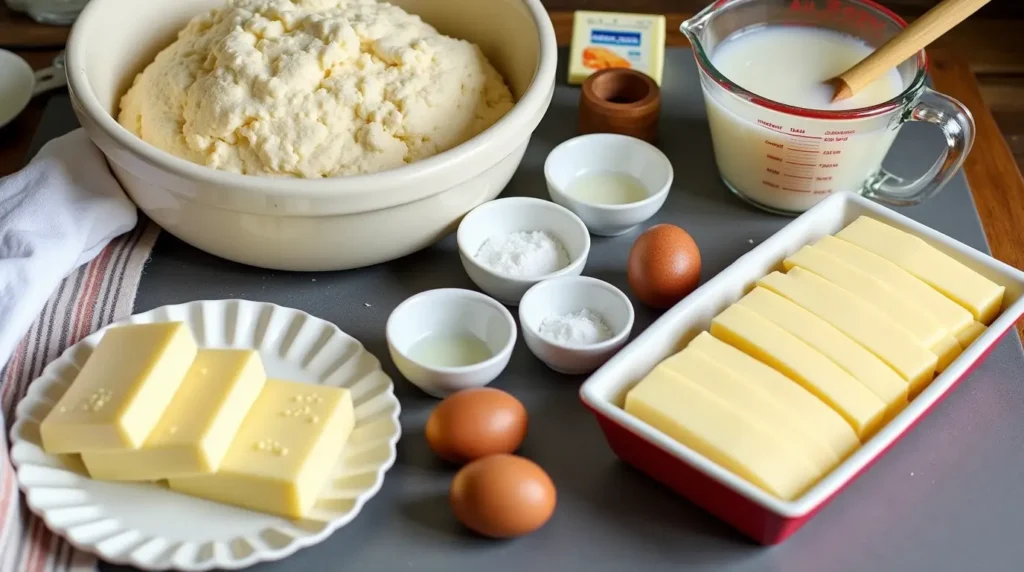
Making perfect Swiss gipfeli dough needs precision and careful attention. Let’s learn the basic techniques that are the foundations of this Swiss classic.
Mixing method
Everything starts with yeast activation. You need to dissolve the yeast in warm milk at precisely 110°F (43°C) and let it become frothy for 5-10 minutes. Mix bread flour, sugar, and salt in a large bowl. Add cold butter cubes to this mixture and work them in until the butter blends into the flour.
Add the activated yeast mixture to your dry ingredients and knead until you get a smooth, elastic dough. Hand kneading takes about 15 minutes, while a stand mixer cuts this time to 10 minutes. The dough should feel smooth and pliable once it’s properly kneaded.
Here’s the mixing sequence you need:
- Combine dry ingredients really well
- Mix in cold butter pieces
- Add activated yeast mixture
- Knead until smooth and elastic
- Shape into a ball for resting
Resting periods
The right resting time helps reshape the scene from a simple mixture to a light, airy base. Put the kneaded dough in a greased bowl and cover it with a damp cloth or plastic wrap. The first rise needs about 45-60 minutes in a warm spot, letting the dough double in size.
After the original rise, wrap the dough tightly in plastic wrap and refrigerate. This cooling period should last at least 30 minutes. Cold temperature firms up the butter within the dough and creates those signature flaky layers that make authentic Swiss gipfeli special.
The best results come when you keep the proofing temperature between 26-28°C with relative humidity at 75-80%. The dough can stay in the refrigerator for up to two days, which gives you flexibility in your baking schedule. This extra chilling time boosts the dough’s structure and makes it easier to shape.
Creating Flaky Layers
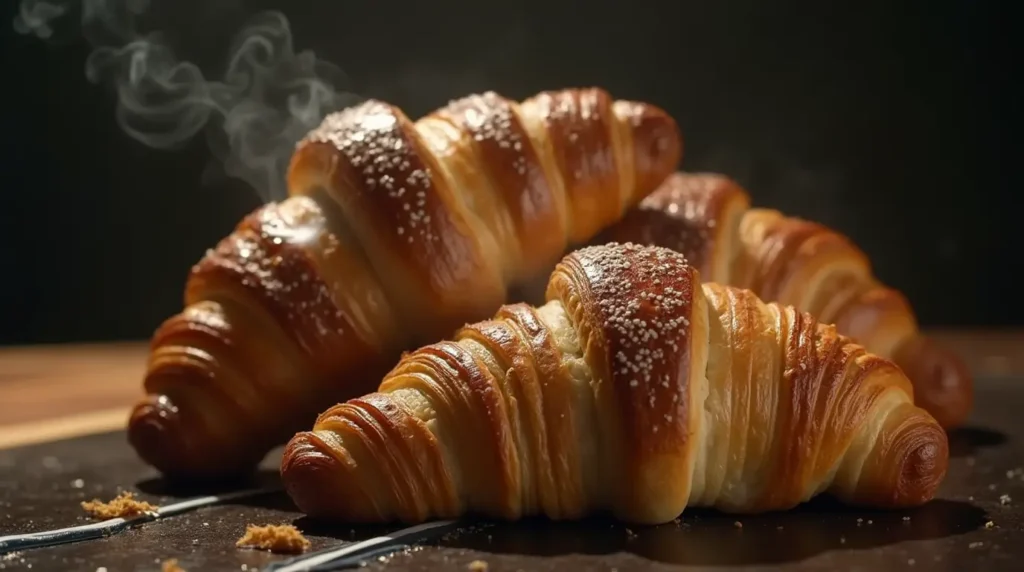
The life-blood of creating those signature flaky layers in your gipfeli recipe is lamination. This process requires you to incorporate butter between dough layers through systematic folding and rolling.
Folding techniques
Swiss gipfeli turns out best with the letter fold method. You need to roll the dough into a rectangle approximately 20 inches long by 10 inches wide. Place the butter, then fold one-third of the dough toward the center, and fold the other third over – just as with folding a letter. Four turns create the ideal honeycomb texture. Any additional folds can actually reduce your layers’ quality.
The folding sequence:
- Roll dough into a rectangle
- Fold one-third toward center
- Fold remaining third over
- Rotate 90 degrees
- Repeat process three more times
Butter block preparation
Your butter block’s quality directly shapes the final texture. High-quality butter with a minimum 82% fat content produces the best results. Shape the cold butter into a square and chill it for 15 minutes. The butter should stay cool yet pliable before you add it to the dough. Hard butter might crack, while soft butter will blend into the dough.
Chilling times
Distinct layers need proper chilling between folds. The dough needs about 30 minutes of refrigeration after each fold. This vital step lets the gluten relax and firms up the butter. The total chilling time adds up to about 4 hours.
Common mistakes
Several problems can pop up from wrong techniques. Dense gipfeli happens when you under-proof or over-knead the dough. The carefully created layers can break down from uneven rolling pressure or too much handling. Temperature control makes all the difference – warm butter blends into the dough instead of creating separate layers.
Keep the temperature just right:
- Roll quickly
- Put dough back in refrigerator if it softens
- Keep your workspace cool
- Handle the dough with care to keep layers intact
Filling and Flavoring Options
Swiss bakeries showcase a wide range of filling options that revolutionize the simple gipfeli into delightful treats. These fillings range from traditional nut-based options to modern chocolate variations that boost the pastry’s versatility.
Traditional Swiss fillings
The classic Nussgipfel features a hazelnut filling we topped with almonds. The nuts need about 4 minutes of toasting before we add them to the filling. Some bakers use Süssmost (apple juice) to create the perfect spreadable consistency, though milk or water work just as well.
Mandelgipfel, another beloved variety, highlights almond-based fillings. Swiss bakers often debate whether to use pre-made almond paste or create their own. Toasting the nuts is vital to develop the best flavor, but you need to watch them carefully to prevent burning.
Modern adaptations
Today’s Swiss bakers have pushed the gipfeli boundaries with creative filling combinations. The chocolate-filled version, known as Schoggi-Gipfeli, comes with chocolate-dipped ends and a rich interior. Fruit lovers can enjoy thin layers of raspberry or apricot jam that create unexpected bursts of sweetness.
Creative variations include:
- Cocoa powder mixed with chocolate chips to create intense flavor
- Cinnamon sugar dusting to add aromatic sweetness
- Pesto spread to bring Mediterranean flair
- Herbs like thyme or rosemary to create aromatic notes
Sweet vs savory
Gipfeli’s versatility shines through its sweet and savory personalities. Traditional versions welcome simple additions like honey or fruit preserves while staying sweet and buttery. The savory options are just as tempting, and cheese-filled variations have become especially popular in Switzerland.
To make savory versions, Schinkengipfeli combines ham and cheese with subtle complexity. The filling mixes mild quark or farmer cheese with mustard undertones. You should skip honey-infused ham varieties as they can overwhelm the delicate filling balance.
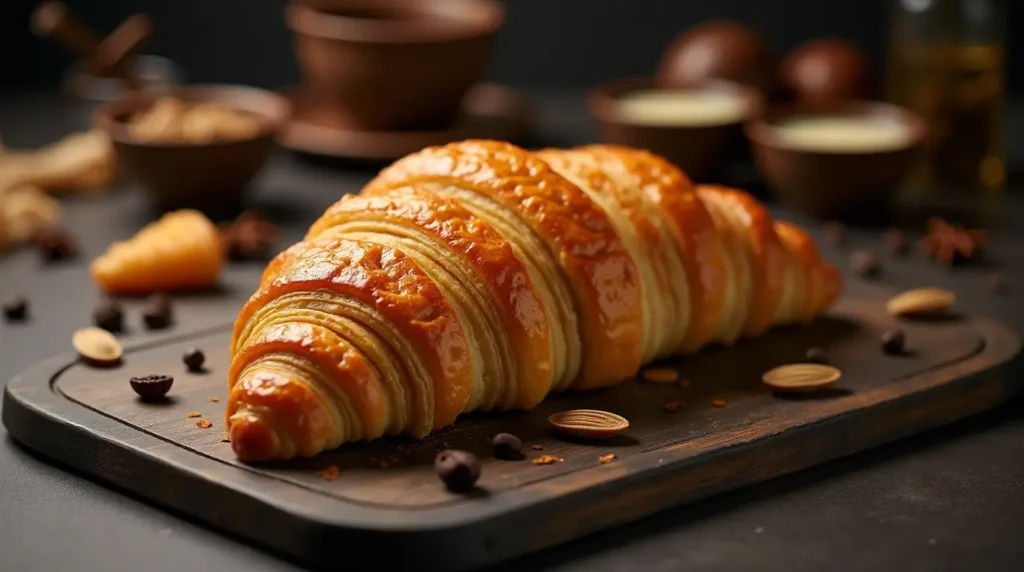
Sweet variations often incorporate:
- Dark chocolate pieces strategically placed before rolling
- Almond paste spread thinly across the dough
- Fruit preserves carefully measured for the best distribution
Savory options feature sophisticated combinations like Gruyère or Emmental cheese that turn gipfeli into satisfying snacks or appetizers. Fresh parsley or dried seasonings add an extra dimension to these classic recipes.
Conclusion
Swiss Gipfeli shows proof of Switzerland’s rich baking heritage with its perfect balance of flaky layers and buttery goodness. Your success depends on becoming skilled at the basics – you need precise temperature control and proper lamination methods.
These delightful pastries work well with both traditional and creative approaches. You can fill them with classic hazelnut paste or try modern savory combinations. Each variation shows how versatile this beloved Swiss treat can be. Patient preparation makes all the difference, so give proper resting time between folds and keep optimal temperatures throughout the process.
Swiss Gipfeli has proven more adaptable than its French cousin. You can try many filling options while the signature crispy exterior stays intact. This makes them perfect for breakfast tables and afternoon gatherings alike.
These buttery crescents should be part of your baking collection. You can find more recipes and food ideas like this one at recipesnutritious.com. This detailed guide will help you create these Swiss delights confidently and bring authentic Swiss bakery flavors right to your kitchen.
FAQs
Q1. What makes Swiss Gipfeli different from French croissants? Swiss Gipfeli have a crispier exterior and contain less butter and sugar compared to French croissants. They offer a unique texture and flavor profile that sets them apart from their French counterparts.
Q2. How long does it take to make Swiss Gipfeli from start to finish? The entire process of making Swiss Gipfeli takes approximately 12 hours. This includes mixing the dough, resting periods, lamination, shaping, proofing, and baking. However, most of this time is passive, allowing for flexibility in your baking schedule.
Q3. What are some traditional fillings for Swiss Gipfeli? Traditional Swiss Gipfeli fillings include hazelnut (Nussgipfel) and almond (Mandelgipfel). These nut-based fillings are often enhanced by toasting the nuts before incorporation to develop optimal flavor.
Q4. Can Swiss Gipfeli be made with savory fillings? Yes, Swiss Gipfeli can be made with savory fillings. Popular savory options include cheese-filled variations and Schinkengipfeli, which combines ham and cheese. These savory versions make for satisfying snacks or appetizers.
Q5. What’s the key to achieving flaky layers in Swiss Gipfeli? The key to achieving flaky layers in Swiss Gipfeli lies in proper lamination technique and temperature control. This involves carefully folding butter into the dough, maintaining cool temperatures throughout the process, and allowing for adequate resting periods between folds.

